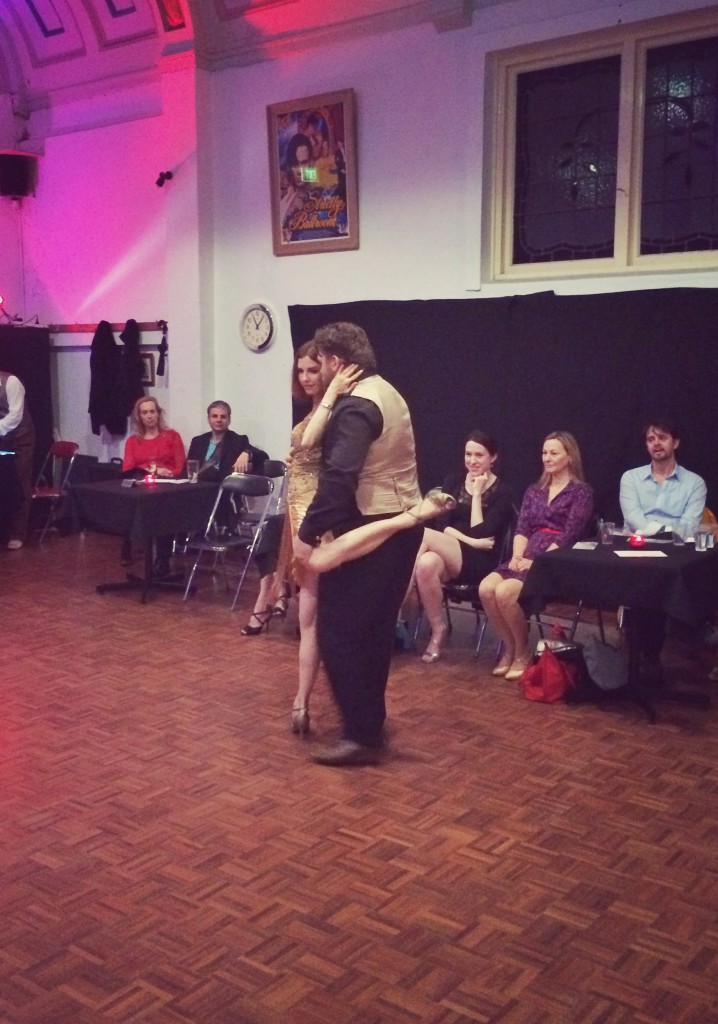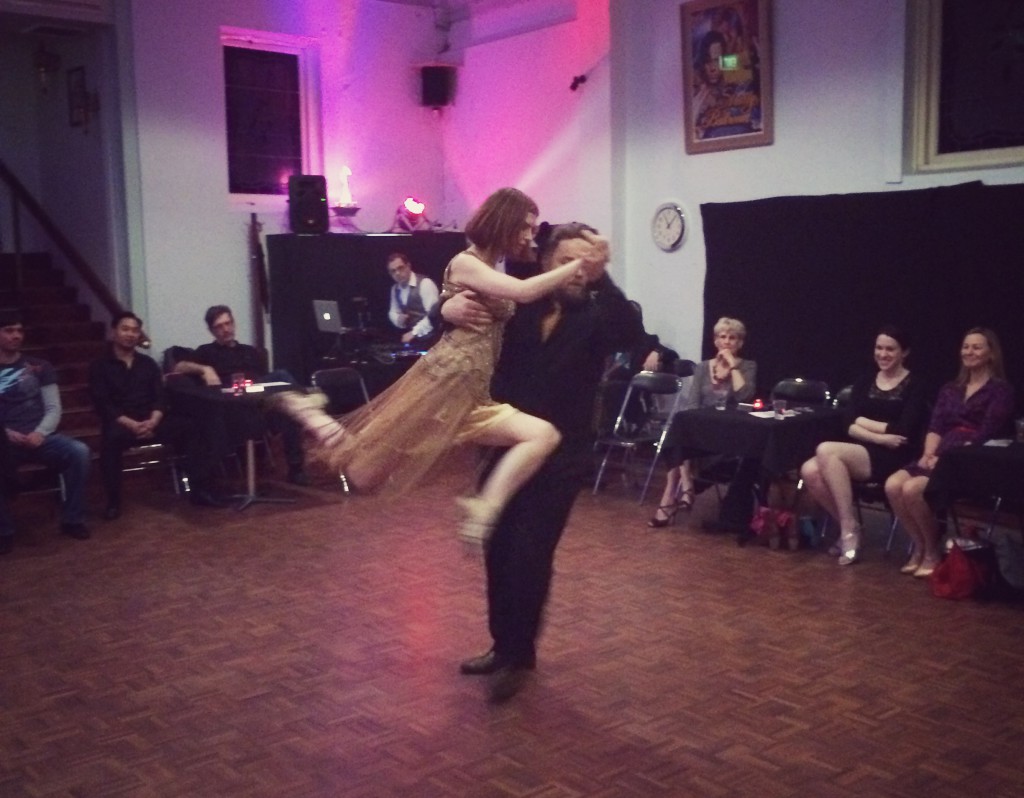Intro by Mona
#thewandererblog
Kseniya is my tango friend and my first memory of her is the moment she wrapped her leg around Craig on the dance floor. I was in my very early days of tango and I said to myself: I must be able to do this one day!. ☺
They are beautiful together, and separately on the dance floor. Passion is exhaled, legs are always moving – like velvet with the music.
It’s always interesting to find out more about the person behind the tango dancer, as at milongas we usually dance and not ask questions. For example, its was through this interview that I I found out Craig and I have one more point in common – we both served in the Air Force! Different countries but still in the Air Force. ☺
Anyway, enough with the talking and let’s see what they have to say about the passion that brought them together. And, don’t forget to book La Gran Milonga, 30 October, Craig and Kseniya are preparing a surprise! WooHoo!

Why tango from all the dances. When did you start and what made you stay?
Kes: Tango was very much under the radar for me; I grew up in Moscow, Russia and was heavily influenced by the ballet as a dance. I would regularly go to Bolshoi theatre to see ballet performances as a little girl with my mother. Once, about 4 years ago, I saw an advert for tango lessons in a magazine. I was going through some difficult times and tango lessons seemed like a good distraction.
Craig: I started learning tango 15 years ago when stationed in Darwin when I was in the air force. With nothing much to do, I went to a dance expo that had tango, after seeing “Scent of a Woman”, and thought it was a good idea. Tango lessons in Darwin were 8 people in a pub on Thursdays with a video tape. We also had visiting instructors, from time to time, but there was usually a lack of women (as it is in Darwin). My favorite workshop was learning Sentadas with Paul, a 6-foot physio rugby prop as a partner – he was the only guy who could lift me, and I was the only one who could lift him.
I keep going back due to the combination of mastery of skills, social interaction and expression, which is tango.
Tell me more about the Latin Dance Championship 2015 and what was the result of your participation?
Kes: When Craig told me about the competition, I googled the name and came across the website for the Australian Latin Dance Championships. It turned out this was the new name for a long-running Australia Salsa Open national competition. And tango was a newly introduced category this year, along with bachata, samba and cafaera, as well as kizomba.
Craig: We had to participate in NSW state qualifier rounds first (in May this year) in order for us to be able to compete in the national competition, along with the other state winners. The first 3 placed qualifiers went on to compete in the nationals. We placed first in NSW and then went on to compete in the National Championships in July. The result was that we came second, in the open Latin Division. We had to compete against other dance styles, as there were not enough entries in the Tango style to make up its own division this year.
When did you decide to compete in the Australian Latin Dance Championships? How did you prepare for the competition?
Craig: In February this year, my really old Brisbane mate from the Air Force, Glenn who also dances tango mentioned that he was asked to enter a tango competition by his dance instructor. Unfortunately he didn’t end up participating this year. However it gave us an idea to enter the competition ourselves.
In order to prepare for the competition, we learnt that it required us to showcase a tango choreography, and since I’ve dabbled a bit in the preparation, and in competition of show tango before, it was a natural progression to do this. I really enjoy a process of choreography creation. It had a number of restrictions; only 2 minutes and maximum of 3 lifts were required.
Kes: Rehearsing a choreography piece was very new and challenging experience for me, as I’m only an amateur dancer, who mostly dances one type of dance style – tango, well and a little bit of salsa. Otherwise I certainly do not have any other dance experience. So at the start, it was tough, especially memorising some of the steps.
How did you guys meet?
Kes: I met Craig dancing tango of course!
Craig: I met Kes across the crowded dance floor.
Kes, what is tango for you, how much of your life is dedicated to this art?
Kes: Since a very young age I loved the art of dance, and was lucky to grow up in Moscow where the ballet/dance culture is very strong, and where I had an opportunity to see the best/world class dance performances. While tango was not something that I grew up with, after learning and dancing it, I realised what a cultural treasure it is, and how special it is among the other dance styles. It’s not just a dance; it creates a very rich and rewarding experience dancing it. Tango dance has a high caliber music genre, sophisticated dance language that stems from a dialogue between the partners. It has interesting cultural and historical background that is still evolving today. I try to go to milongas whenever I can, but when I don’t have the time then I would watch some tango videos or listen to tango music instead.
Craig, what brings the most satisfaction from tango?
Tango has a number of aspects I like, the concept of mastery of steps and technique and musicality, but also the mystery of the connection between two people.
How important is the social element of tango for you?
Kes: As I believe that dance is about artistic expression and a dialogue on the dance floor, I best enjoy dancing with people who are like-minded in that respect. I like to dance with leaders who enjoy the music and the richness of the dance and expression. While I know a lot of people think about tango as a “hug dance”, I certainly don’t view it that way. To me it’s much more than that!
Craig: The social aspect of dance is very important. A connection can range from simple laugh and giggles to the touching of souls.
What is the advice you would give to someone who wants to start learning tango?
Kes: Don’t get hung up on the “technique” as that comes with time. Most importantly, listen to the music and feel it, just enjoy dancing. Also try to learn and understand the dance concepts before implementing something on the dance floor. And don’t be afraid to make mistakes. That’s how all of us learn.
Craig: Tango is very easy to learn, lots of people try to over complicate it. It is just a single step followed by a pivot; you can build any figure with these two fundamentals.
Do you see yourself at this moment dancing anything else than tango?
Kes: Once you start dancing tango it’s hard to do anything else, as it’s so time consuming. However I do like kizomba, and would like to learn it a bit more.
Craig: Over the years I’ve danced a variety of dance styles: salsa, West Coast Swing, Ceroc. However tango always pulls you back.
Let’s talk about fashion…
Kes: My humble opinion is, I think people should be less casually dressed when they come to dance tango at milongas. The whole point of the milonga is that we create this whole alternative world and atmosphere, to get away from real life and to express ourselves. Why not be dressed interestingly? Life is too short to be dressed shabbily.
Craig: There certainly a time and place for everything. From causal to smart, depending of the event.
What is your opinion about tango etiquette? Is it outdated or rules should apply no matter what?
Kes: I think it’s outdated, we’re not in the 1900’s, where women had to be accompanied by a chaperone to come to dance and wink and nod at men to get their attention. World has moved on from there. I’d like the rules to be more fluid, as the world is also more fluid these days. Cabeceo is outdated and doesn’t work for everyone. For example, I don’t have a very good vision, especially in the dimly lit milonga hall. When the lighting is dim I can’t see people’s faces that well, even in my glasses, and it’s not conducive to cabeceo. If anyone wants to dance with me, I think they should be able to just come up to me and ask, it’s much more direct.
Craig: My biggest pet hate is the prolonged chat that people have on the dance floor at the beginning of songs. You often hear of the line of dance, dance floor craft etc, but if people fail to start with the beginning of the song, it disrupts the whole dance floor. The worst I have seen it, when people would talk for up to half of the song. And as the tanda continued, people, expected people to talk, so no one expected to start at the beginning of the song. You’re on the dance floor, please dance, not stand and chat. If you want to chat, leave the dance floor, it’s not very courteous to other dancers. I think the set up at milongas could be better, with more attention given to general mingling of people to encourage social interaction outside the dance floor. This way more people will dance with a greater variety of other people without having to rely on cabeceo.
A last word, anything you want to share with our readers?
Craig: It always amuses me when people after complimenting me or Kes on our dancing ask us how long we danced tango for. I think it’s a nonsensical question to ask, as it’s a bit pointless. Dancing for a long time doesn’t qualify you as a good dancer, there are plenty of people who happily dance all their lives to the same level. Plus everyone’s level and capacity for improvement is different. There has to be a genuine motivation to improve before you can become better at dancing. The better question would be to ask someone who is a good dancer would be how do they learn…
Kes and Craig, thank you! Have a hug and see you on the dance floor! Mona

